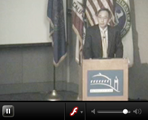


Ultrasound and underwater sonar devices could "see" a big improvement thanks to development of the world’s first acoustic hyperlens. Created by Berkeley Lab researchers, the acoustic hyperlens provides an eightfold boost in the magnification power of sound-based imaging technologies. Clever physical manipulation of the imaging sound waves enables the hyperlens to resolve details smaller than one sixth the length of the waves themselves, bringing into view much smaller objects and features than can be detected using today’s technologies. More>
 Susan Hubbard, a staff scientist in the Earth Sciences Division and leader of its Environmental Remediation Program, has been honored with the Frank Frischknecht Award for 2009. This award recognizes "extraordinary leadership and innovation that has transformed the nature and capabilities of near surface geophysics." The honor was presented jointly by the Near Surface Geophysical Society of Exploration Geophysicists and by the Environmental and Engineering Society. Hubbard’s research focuses on the use of geophysical methods for shallow subsurface characterization and monitoring, with a particular emphasis on integration of geophysical, hydrological, and biogeochemical datasets to understand complex subsurface processes.
Susan Hubbard, a staff scientist in the Earth Sciences Division and leader of its Environmental Remediation Program, has been honored with the Frank Frischknecht Award for 2009. This award recognizes "extraordinary leadership and innovation that has transformed the nature and capabilities of near surface geophysics." The honor was presented jointly by the Near Surface Geophysical Society of Exploration Geophysicists and by the Environmental and Engineering Society. Hubbard’s research focuses on the use of geophysical methods for shallow subsurface characterization and monitoring, with a particular emphasis on integration of geophysical, hydrological, and biogeochemical datasets to understand complex subsurface processes.
 The Lab will host an Emergency Preparedness Consumer Expo on Thursday from 11 a.m. to 1:30 p.m. in Perseverance Hall (Bldg. 54). Sponsored by the Lab’s Emergency Services Program in conjunction with the Employee Activities Association, the expo will feature a variety of emergency preparedness and response supplies for sale, such as disaster kits of all sizes, first-aid kits, earthquake putty and furniture straps, tools, gear, flashlights, important information, and much more. For more information, contact Rocky Saunders, x7032.
The Lab will host an Emergency Preparedness Consumer Expo on Thursday from 11 a.m. to 1:30 p.m. in Perseverance Hall (Bldg. 54). Sponsored by the Lab’s Emergency Services Program in conjunction with the Employee Activities Association, the expo will feature a variety of emergency preparedness and response supplies for sale, such as disaster kits of all sizes, first-aid kits, earthquake putty and furniture straps, tools, gear, flashlights, important information, and much more. For more information, contact Rocky Saunders, x7032.
 DOE Update: Energy Research Projects Win $151 Million in Funding
DOE Update: Energy Research Projects Win $151 Million in FundingThe Department of Energy yesterday announced major funding for 37 ambitious research projects — including some that could allow intermittent energy sources like wind and solar to provide a steady flow of power, or use bacteria to produce automotive fuel from sunlight, water and carbon dioxide. The $151 million in funding is being awarded through the Department’s Advanced Research Projects Agency-Energy (ARPA-E), headed by former Berkeley Lab researcher Arun Majumdar. More>
 Web Feature: Archived Version of Secretary Chu’s Talk Now Online
Web Feature: Archived Version of Secretary Chu’s Talk Now OnlineStaff unable to attend Secretary Chu’s talk yesterday or view the webcast can now view an archived version of his presentation online. Chu discussed how the Department of Energy, with the help of its national labs, is tackling climate change with energy efficiency and alternative energy research and application. During the live webcast, some viewers reported problems with the audio portion.
Today at Berkeley Lab is produced by Public Affairs' Communications Group